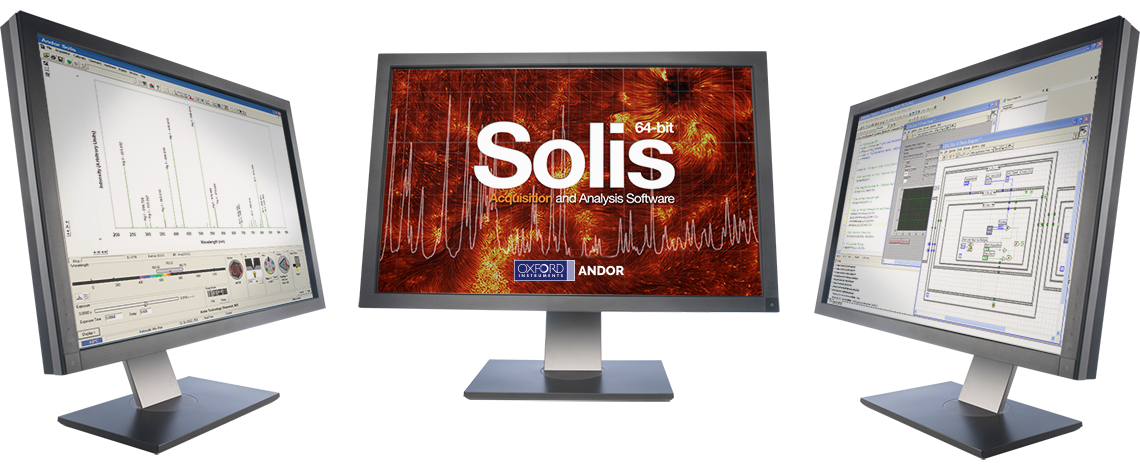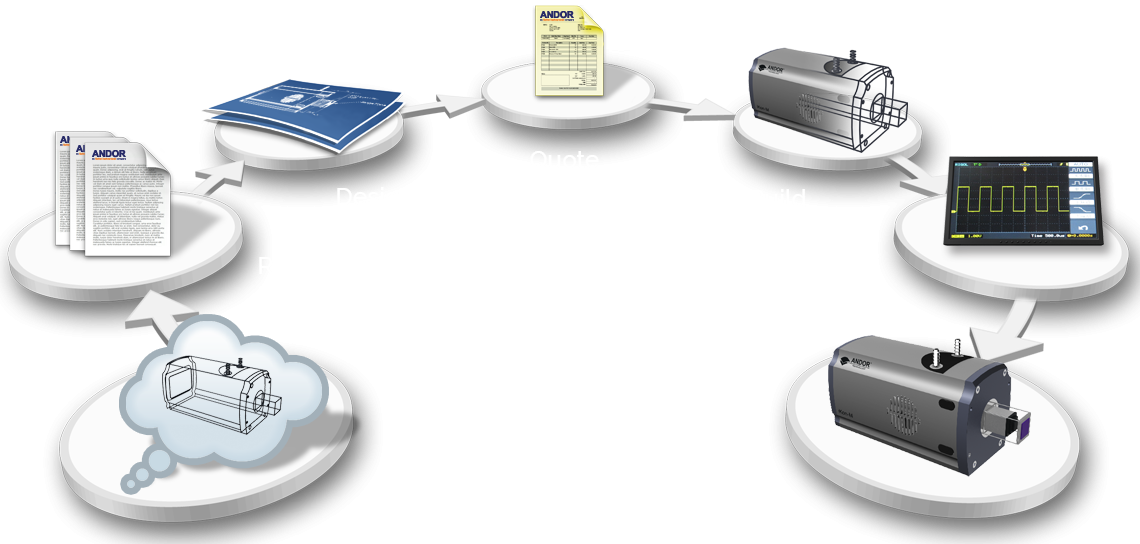无窗口(‘SO’)和带铍窗 (‘SY’)X射线相机
- 兼具光谱和成像模式
- 高VUV/EUV/XUV 灵敏度
- 大视场,像面尺寸61.4 x 61.7 mm
- 可热电制冷至-100°C
- 超高真空兼容
Andor能够提供一系列高灵敏、高动态范围和快速探测的CCD、sCMOS和EMCCD相机,为小型实验室或同步辐射线站提供探测解决方案。这些探测器被广泛运用在不同研究领域,例如涉及到EUV、X射线、中子或电子探测的材料科学、等离子体研究、生物样本分析或光束/源表征等研究领域。
全新 Marana-X
高帧率X射线直接探测背照式sCMOS相机
Andor提供无窗口直接X射线探测相机(SO)系列,也提供UltraVac™ 技术的可独立安装的带铍窗 的(SY)系列。此外,Andor还提供高通量光纤和透镜耦合间接探测解决方案,以满足不同的需求。
模块化闪烁体选项
Specifications
从以下选项中选择最能满足您需求的探测器。
Spectral Rate
Pixel well depth
Simultaneous bandpass
Image rate
Pixel well depth
Field of view
Spectral Rate
Pixel well depth
Simultaneous bandpass
Image rate
Pixel well depth
Field of view
(*) Please contact your local Andor representative for further details
Spectral rate
Pixel well depth
Simultaneous bandpass
Image rate
Pixel well depth
Field of view
By exploiting the power of the water window region of the electromagnetic spectrum in which water is transparent to X-rays 282 eV (carbon K-edge) – 533 eV (oxygen K-edge) it is possible to study organic species in vivo cryogenically suspended to preserve their natural shape and structure. X-rays offer a unique non-destructive, in situ and in operando diagnostic technique to study the structure and biology of organic samples without the degradation often seen in electron microscopy techniques.
The advent of higher repetition rate lasers for high harmonic generation, synchrotron source upgrades and the development of X-ray free electron lasers is enabling brighter and higher repetition soft X-ray sources for the characterisation of organic species. Andor’s market leading sCMOS Marana-X camera combines the exceptional speed of sCMOS technology with low noise, high dynamic range readout with unparalleled quantum efficiency to meet the increasingly demanding imaging requirements driven by these technological advances. Furthermore, Andor’s open front iKon CCD range also offers extremely low dark current, high dynamic range and low noise readout for flux starved environments.
Faster generation of high resolution spectra for the analysis of dynamic processes are of increasing importance at beamtime-limited synchrotrons and lab-based high energy sources facilities. The development of high dynamic range, rapid CCD and sCMOS cameras is already benefiting applications spanning from Material Science, Biology & Medical to High Harmonic Generated X-ray Absorption Spectroscopy (XANES).
The increasing brightness and coherence of high energy synchrotron and HHG facilities has seen increasing demand for high speed and sensitivity cameras to meet cutting edge research requirements. Andor has two product ranges specifically tailored to address these requirements:
Faster generation of high resolution, high contrast 3D X-ray tomographic reconstruction and real time imaging of fast processes are of increasing importance at beamtime-limited synchrotrons and lab-based high energy sources facilities, benefiting applications spanning from Material Science, Biology & Medical, Energy (including fuel cells/batteries/engines) to Fluid Dynamics.
With the advent of high repetition high harmonic generation lasers and the increasing brightness of laboratory based and synchrotron sources, high speed and sensitivity cameras are increasingly required to meet cutting edge research requirements. Andor has two product ranges specifically tailored to address these requirements:
X-ray-based diagnostics can provide information on the inner structure, damages, authenticity, manufacturing and restoration processes of cultural heritage artefacts including for example metal objects (e.g. lead, bronze or iron-based weaponry or statues), ceramics, or samples combining metallic and organic materials (e.g. wood, adhesives, soil, leather, lacquer). It can also provide quantitative physiological investigation of fossilised artefacts.
In Geology, this technique can give information on rock formation processes, their crystal phases and behaviour with temperature and pressure, macroscopic strain/stresses/internal cracks, porous systems and flow systems. In planetary science, it can be used for the structural classification of iron-based meteorites.
Other applications relevant to this section include the study of structural robustness of construction material (cement/concrete), visualisation of moisture and multiphase flows in porous and hygroscopic medias, or study of engineered materials structural (e.g. crystalline phases, microstructures, heterogeneities, stress/strain/cracks through Bragg-edge, Small Angle X-ray Scattering (SAXS) or Grating Interferometry imaging techniques) and magnetic properties.
Andor has two product ranges specifically tailored to address the challenging requirements for energy and engineering X-ray diagnostics:
By exploiting the high penetration power of X-rays, non-destructive, in situ and in operando diagnostics can be undertaken to study dynamic chemical processes and flow in enclosed engineered systems, or study the integrity and quality of high precision mechanical components.
X-ray-based diagnostics is appealing to the Automotive, Aerospace and manufacturing industries. It provides a diagnostics tool for quality control and mechanical integrity verification of engineered parts (e.g. engine parts, turbine and rotor blades). Bragg-edge, Small Angle X-ray Scattering (SAXS) imaging techniques are typically used to identify strain/stress/cracks in the bulk material.
Other areas of interest for using X-ray diagnostics include the spatial and temporal analysis of chemical processes (e.g. corrosion, chemical processes product deposition) and flows/multi-phase flows (e.g. water or oil flows) within combustion engines and fuel injection systems or electrochemical energy storage and conversion systems e.g. ion-Lithium batteries or fuel cells.
Andor has two product ranges specifically tailored to address the challenging requirements for energy and engineering X-ray diagnostics:
Neutron imaging is a technique typically used to analyse samples containing low- atomic number elements that provide best neutron attenuation characteristics (through absorption, scatter), e.g. Hydrogen, Nitrogen or Lithium. It is a complementary technique to X-ray imaging which relies on different interaction mechanisms with matter.
Neutron computed tomographic (CT) reconstructions are obtained from a series of two-dimensional images (cross sections) of the samples taken at different angles. These 2D projections can be combined through software computation to build a three-dimensional view of the inside of the sample.
These non-destructive techniques can be used to study hydrogenous fluid dynamics or fluid distribution (e.g. water) in metal objects, corrosion processes, complex archaeological artefacts or geological samples inner structures. They can also be used for quality control of engineering systems (e.g. combustion engines, Li-ion batteries, fuel cells), to discriminate isotopes of the same element or to study water transport in biological materials (e.g. plants).
Neutron images are typically acquired using a scintillator (generally made of Lithium-based materials (e.g. LiF(ZnS) or plastic)), lens – coupled to a CCD or sCMOS detector. Andor’s unique Balor-X sCMOS camera offers unparalleled rapid 54 FPS full frame readout, 16 megapixel camera, with low noise and high dynamic range readout. Andor’s iKon-L and iKon-XL CCDs provide simultaneously large field of view, high dynamic range and low dark current, while Andor CB2 or ZL41 Wave sCMOS offers simultaneously fast acquisition rates and high dynamic range. If high time resolution is required Andor’s iStar sCMOS offers unparalleled frame rates with nanosecond gating capabilities.
By exploiting the strong attenuation of neutrons by low atomic number (Z) elements (e.g. Hydrogen) and their high penetration power for high-Z elements-based materials, neutron imaging/tomography can carry deep-analysis for wide range of material configurations in a non-destructive manner.
Neutron-based diagnostics can provide information on the inner structure, damages, authenticity, manufacturing and restoration processes of cultural heritage artefacts including for example metal objects (e.g. lead, bronze or iron-based weaponry or statues), ceramics, or samples combining metallic and organic materials (e.g. wood, adhesives, soil, leather, lacquer). It can also provide quantitative physiological investigation of fossilised artefacts.
In Geology, this technique can give information on rock formation processes, their crystal phases and behaviour with temperature and pressure, macroscopic strain/stresses/internal cracks, porous systems and flow systems. In planetary science, it can be used for the structural classification of iron-based meteorites.
Other applications relevant to this section include the study of structural robustness of construction material (cement/concrete), visualisation of moisture and multiphase flows in porous and hygroscopic medias, or study of engineered materials structural (e.g. crystalline phases, microstructures, heterogeneities, stress/strain/cracks through Bragg-edge, Small Angle Neutron Scattering (SANS) or Grating Interferometry imaging techniques) and magnetic properties.
Lens-coupled with Li-based scintillators, Andor’s unique Balor-X sCMOS camera offers unparalleled rapid 54 FPS full frame readout, 16 megapixel sensor, with low noise and high dynamic range readout, Andor’s iKon-L and iKon-XL CCDs provide simultaneously large field of view and high dynamic range, while Andor CB2 or ZL41 Wave sCMOS offers simultaneously fast acquisition rates and high dynamic range. If high time resolution is required Andor’s iStar sCMOS offers unparalleled frame rates with nanosecond gating capabilities.
By exploiting the high penetration power of neutrons through high-Z elements-based materials, non-destructive, in situ and in operando diagnostics can be undertaken to study dynamic chemical processes and flow in enclosed engineered systems, or study the integrity and quality of high precision mechanical components.
Neutron-based diagnostics is appealing to the Automotive, Aerospace and manufacturing industries. It provides a diagnostics tool for quality control and mechanical integrity verification of engineered parts (e.g. engine parts, turbine and rotor blades). Bragg-edge, Small Angle Neutron Scattering (SANS) or Grating Interferometry imaging techniques are typically used to identify strain/stress/cracks in the bulk material.
Other areas of interest for using neutron diagnostics include the spatial and temporal analysis of chemical processes (e.g. corrosion, chemical processes product deposition) and flows/multi-phase flows (e.g. water or oil flows) within combustion engines and fuel injection systems or electrochemical energy storage and conversion systems e.g. ion-Lithium batteries or fuel cells.
Fuel Cell research (e.g. Polymer electrolyte fuel cells) aims to provide non-polluting power source for the automotive industry. Neutron-based diagnostics is used for in situ/in operando study of the behaviour of Hydrogen – the key fuel element for fuel cells alongside oxygen – and water - the main product of the hydrogen/air fuel cell process.
Lens-coupled with Li-based scintillators, Andor’s unique Balor-X sCMOS camera offers unparalleled rapid 54 FPS full frame readout, 16 megapixel sensor, with low noise and high dynamic range readout, Andor’s iKon-L and iKon-XL CCDs provide simultaneously large field of view and high dynamic range, while Andor CB2 or ZL41 Wave sCMOS offers simultaneously fast acquisition rates and high dynamic range. If high time resolution is required Andor’s iStar sCMOS offers unparalleled frame rates with nanosecond gating capabilities.
Neutron imaging is used as a powerful technique in studying the internal features of biological specimens without compromising the integrity and internal structure of samples. In particular the strong interaction of neutrons between hydrogen and deuterium enable unprecedented insights into biological processes.
Of particular interest is the ability to increasingly do rapid in situ neutron radiography to collect rapid neutron tomography datasets to enable real time analysis of biological processes such as water transport within root systems. Furthermore, the advent of spallation sources is increasingly enabling the ability to collect biological data sets with multispectral energy resolved imaging datasets.
Lens-coupled with Li-based scintillators, Andor’s unique Balor-X sCMOS camera offers unparalleled rapid 54 FPS full frame readout, 16 megapixel sensor, with low noise and high dynamic range readout, Andor’s iKon-L and iKon-XL CCDs provide simultaneously large field of view and high dynamic range, while Andor CB2 or ZL41 Wave sCMOS offers simultaneously fast acquisition rates and high dynamic range. If high time resolution is required Andor’s iStar sCMOS offers unparalleled frame rates with nanosecond gating capabilities.
可进行广泛的各类设置,灵活的附件配置,可现场升级。
真空腔,或者独立式相机配件

Solis采集软件:一个32位和全64位支持的应用程序(适用于Windows 7, 8, 8.1 和10),可提供丰富的数据采集和处理功能。
Learn More软件开发工具包:兼容32位和64位库(适用于Windows 7, 8, 8.1 和10)。兼容适用于Windows/Linux 的C/C++、C#、VB.NET、Matlab和LabVIEW
Learn More第三方开源平台:EPICS和TANGO-LIMA是可用于全球许多粒子加速器和大型科学仪器的硬件控制的开源软件平台。支持这些平台的Andor相机包括SDK2 / SDK3、 Windows和/或Linux上的CCD和 sCMOS。请参考下面的链接以了解更多信息。
“客户服务”是Andor的核心理念,我们致力于为每一位客户提供高性能、高质量的产品和解决方案。Andor可提供定制服务,我们有一个专设的、经验丰富的工程师及应用专家团队,努力提供针对客户需求的解决方案。


欢迎您与当地的Andor销售工程师联系,以便进一步了解我们的CSR(客户特殊需求服务)能够为您和您的项目提供哪些帮助。
The Learning Centre hosts a wide range of technical articles and webinars on various applications and techniques. Below are some key articles that are related to cameras for x-ray, euv, electron and neutron detection for further reading:
Specifications:
Specifications:
 公安机关备案号31010402003473
公安机关备案号31010402003473
